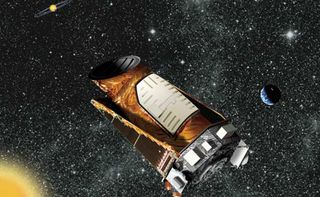NASA to Reveal Big News From Planet-Hunting Spacecraft Today

This storywas updated Aug. 26 at 12 a.m. ET.
NASA isexpected to make a major announcement today on the progress of its Keplerspacecraft, which has been staring at one patch of space for evidence of otherworlds.
The spaceagency has set an afternoon teleconference with reporters to discuss theresults from Kepler, which include the "discovery of an intriguingplanetary system," according to a space agency statement released Monday. [TheStrangest Alien Planets]
Participatingin the teleconference will be senior NASA scientists and Kepler missionresearchers, including principal investigator William Borucki of ?the spaceagency's Ames Research Center in Moffett Field, Calif.
The Keplerspace observatory hunts for Earth-likeplanets around other stars. In June, mission scientists announced that thetelescope had found over 700 candidates, including five systems that appearto have more than one transiting planet.
The spacecraftmonitors stars for subtle changes in their brightness, which could indicatethat alien planets are passing in front of them as seenfrom Earth. To date, astronomers have discovered more than 400 extrasolar planetsaround stars beyond our solar system.
NASA launchedthe $600 million Kepler spacecraft in March 2009. It is currently staring at apatch of the Milky Way that contains over 156,000 stars ? a star field in theconstellations Cygnus and Lyra.
Get the Space.com Newsletter
Breaking space news, the latest updates on rocket launches, skywatching events and more!
Astronomershave been using the data from Kepler to determine whether orbiting planets areresponsible for the variation in brightness of several hundred stars.
Follow-upobservations are necessary to distinguish between actual planets and falsealarms such as binary stars, which are two stars that orbit eachother.
Today'sannouncement comes on the heels of a separate discoveryof at least five planets ? with hints of two more ? circling around a starin an arrangement similar to our own solar system.
Thatdiscovery (which included up to seven alien planets ? including one that couldbe 1.4 times the mass of Earth) was made by astronomers using the EuropeanSouthern Observatory in Chile. They discovered the planets 127 light-years fromEarth around the star HD 10180 in a pattern that looks strikingly like oursolar system, only in a more compact arrangement.
- Gallery - Strangest Alien Planets
- Top 10 Extreme Planet Facts
- Hundreds of Possible Alien PlanetsDiscovered By NASA Spacecraft
Join our Space Forums to keep talking space on the latest missions, night sky and more! And if you have a news tip, correction or comment, let us know at: community@space.com.

Denise Chow is a former Space.com staff writer who then worked as assistant managing editor at Live Science before moving to NBC News as a science reporter, where she focuses on general science and climate change. She spent two years with Space.com, writing about rocket launches and covering NASA's final three space shuttle missions, before joining the Live Science team in 2013. A Canadian transplant, Denise has a bachelor's degree from the University of Toronto, and a master's degree in journalism from New York University. At NBC News, Denise covers general science and climate change.
